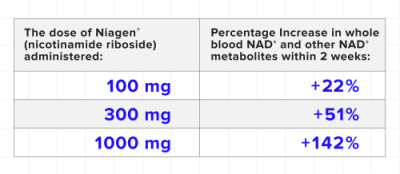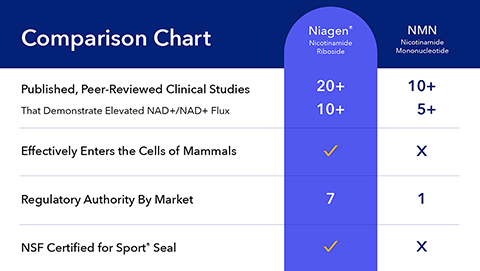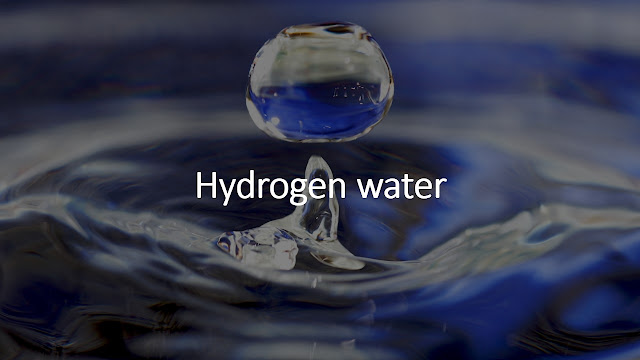NMN vs NR: TruNiagen version (2023)
In recent years, NAD+ has come to the forefront of research on aging, health, and disease. However, the popularity of NAD+ research has also opened the door for misinformation about NAD+ and NAD+ precursors.
For example, an NAD+ precursor is a “building block” for the cell to build NAD+. However, orally consumed NMN is technically a precursor to nicotinamide riboside and must be converted to NR before it can pass through cell membranes. Inside the cell, the NR converts back to NMN, and then to NAD+. Given that NR can enter cells, this distinction is important to make when it comes to efficiency.
So, which one should you trust? The evidence overwhelmingly favors Niagen, but here’s a breakdown to adequately assess both NAD+ precursors in detail.
Almost Twice as Much Ongoing Clinical Research Uses Niagen over NMN
According to Clinicaltrials.gov, a government-sponsored database of human clinical studies, as well as the World Health Organization (WHO) International Clinical Trials Registry, there are more than 40 ongoing or completed studies involving Niagen versus more than 20 for NMN.These numbers show double the growing amount of research behind Niagen over NMN to investigate the various health benefits of raising NAD+ levels in humans.
Niagen Has 10+ Published Human Clinical Studies Demonstrating That It Effectively Increases NAD+ and/or NAD+ Flux, While NMN Has 5+
To date, a collection of human clinical studies comprehensively shows that Niagen effectively and safely increases NAD+ and/or NAD+ flux (the rate at which cells make and use NAD+). The continued use of Niagen in these trials further reflects the trust that the precursor commands in the scientific community.Before You Get Started: A Short Glossary of Clinical Study Terminology
A crossover trial is one in which all subjects receive all the interventions in the study, but the order in which they are given the intervention is randomized. For example, 10 subjects in an 8-week study might be randomized to receive NR for 4 weeks and then receive a placebo for the next 4 weeks. Another set of 10 subjects would experience the opposite order.
Double blind:A double-blind study is a randomized clinical trial in which neither the patient nor the physician(s) know whether an experimental treatment, standard treatment, or placebo is being administered. Only those directing the study know which patients receive which treatments. This prevents bias when doctors evaluate outcomes, and improves the reliability of the trial’s results.
Parallel-group design:A parallel study is probably the most common study design. Treatments each have an ”arm,” which might include a particular dosage, a placebo, or other type of care. In parallel studies, participants are randomly assigned to each arm, and remain in that arm throughout the study duration.
Pharmacokinetics:Pharmacokinetics is the study of the movement of a substance into, through, and out of the body—the complete time course of its absorption, bioavailability, distribution, metabolism, and excretion.
First Human Niagen Study That Demonstrates Effectiveness:
A study published in Nature Communications in 2016 reports that single oral doses of 100mg, 300mg, and 1,000mg of Niagen can safely elevate NAD+ levels. Researchers investigated the effects of NR supplementation in 12 healthy men and women, establishing both its safety and efficacy as an NAD+ precursor in humans.
Second Human Niagen Study That Demonstrates Effectiveness:
A study published in PLOS One in 2017 monitored the effects of Niagen with a gradual increase in dosage. The study administered 250mg of Niagen to eight healthy volunteers on Days 1 and 2, then gradually administered higher doses each subsequent day. On days 7 and 8, the study administered a peak dose of 1,000mg twice daily. The study concluded on Day 9, showing oral administration of Niagen to be well tolerated in humans with no adverse effects.
Third Human Niagen Study That Demonstrates Effectiveness:
A study published in Nature Communications in 2018 shows that Niagen supplementation is well tolerated and effectively elevates NAD+ in a group of healthy middle-aged and older adults. The subject cohort was comprised of 60 healthy men and women between the ages of 55 and 79. The study administered a dosage of 500mg twice per day for six weeks in a randomized, placebo-controlled, and crossover-designed trial.
Fourth Human Niagen Study That Demonstrates Effectiveness:
A study published in the American Journal of Clinical Nutrition in 2018 concluded that 2,000mg of daily Niagen supplementation over a period of 12 weeks is safe. In addition, the subjects showed an increase in NAD+ metabolites in urine samples.
The researchers administered 1,000mg of Niagen twice daily over a period of 12 weeks in a randomized, placebo-controlled, double-blind, parallel-group designed trial. The subjects consisted of 40 healthy, obese men ranging in ages from 40-70.
Fifth Human Niagen Study That Demonstrates Effectiveness:
A clinical trial published in Scientific Reports in 2019 concludes Niagen both safely and effectively increases NAD+ levels in a dose-dependent manner in healthy overweight adults. The study used an eight-week randomized, double-blind, placebo-controlled trial to conduct its evaluation. After two weeks, the study results are as follows:

Sixth Human Niagen Study That Demonstrates Effectiveness:
A study published in Cell Reports in 2019 investigated the effects of Niagen on skeletal muscle. The study supplemented 12 marginally overweight older men with 1,000mg of Niagen daily for 21 days. The study used a randomized, double-blind, placebo-controlled, crossover-designed trial and concluded, “oral nicotinamide riboside increased human skeletal muscle NAAD, a sensitive marker of increased NAD+ metabolism.”
Seventh Human Niagen Study That Demonstrates Effectiveness:
A study published in The American Journal of Clinical Nutrition in 2020 investigated the effects of Niagen on metabolic health, muscle metabolism, and mitochondrial function. The study was a randomized, double-blind, placebo-controlled, crossover trial of 13 healthy overweight and obese adults. Similar to the previous study, NR supplementation significantly increased markers of enhanced NAD+ metabolism in human skeletal muscle.
Eighth Human Niagen Study That Demonstrates Effectiveness:
A pilot study published in Molecular Systems Biology in 2020 investigated the pharmacokinetics of Niagen in combination with other supplements. The study combined NR with L-serine, N-acetyl-L-cysteine, and L-carnitine for their potential benefits in humans, particularly those with higher liver fat content. Mathematical modeling results showed increased fat metabolism, decreased glucose metabolism, and increased synthesis/turnover of NAD+, carnitine, and glutathione.
Ninth Human Niagen Study That Demonstrates Effectiveness:
An ex vivo and pilot clinical study published in the Journal of Clinical Investigation investigated mitochondrial dysfunction in peripheral blood mononuclear cells (PBMCs, or white blood cells). The study showed that NR increased whole blood NAD+ levels and the mitochondrial respiration rate of PBMCs.
Tenth Human Niagen Study That Demonstrates Effectiveness:
A study published in The Journal of Physiology investigated the effects of Niagen supplementation on whole-body metabolism and exercise-induced mitochondrial signaling in skeletal muscle. The study showed increased markers of NAD+ flux, demonstrating the skeletal muscle bioavailability of NR supplementation.
Eleventh Human Niagen Study That Demonstrates Effectiveness:
A 2022 study explored the effects of NR on monocytes (a type of white blood cell) taken from both healthy subjects and subjects with systemic lupus. The study included analyses of the mechanism behind NR’s effects, as well as a randomized, double-blind, placebo-controlled pilot study of 35 healthy participants who were given 1,000mg of NR for seven days. NR was shown to increase whole-body NAD+ levels along with levels of related NAD+ metabolites. Increasing NAD+ via NR supplementation reduced type-I interferon (IFN) signaling, which plays an important role in immune response.
Twelfth Human Niagen Study That Demonstrates Effectiveness:
Another 2022 study assessed the tolerability, safety, and cerebral penetration of NR therapy (1,000mg per day for 30 days) in humans. They also sought to determine if NR has an impact on neurometabolic profiles and on motor function. NR supplementation significantly increased cerebral NAD+ levels and altered metabolic patterns in the brain. Patients experienced a mild but significant clinical improvement that correlated with these pattern changes, with no adverse effects.
Thirteenth Human Niagen Study That Demonstrates Effectiveness:
Another study in humans assessed the safety and tolerability of NR at 2,000mg/day for 12 weeks. Exploratory end points included identifying changes in functional capacity and heart function. High-dose NR supplementation was safe and well tolerated, nearly doubled whole-blood NAD+ levels, and increased PBMC mitochondrial respiration.
Nicotinamide riboside can enter cells directly. NMN cannot.
A collection of published studies conducted by some of the field’s leading researchers demonstrates that NMN cannot enter cells directly; rather, it must be converted to NR first.
One such study (published in Nature Communications in 2016) on NMN’s metabolism in mammalian cells concluded NMN cannot directly enter the cell. Simply put, NR enters cells directly; NMN does not.
NR and NMN are chemically identical, with the exception of one phosphate group present on NMN. The study demonstrates that this additional phosphate group must be removed from NMN, converting it into nicotinamide riboside before it can enter the cell.
However, a study published in Nature Metabolism in 2019 claimed to have identified a transport protein for NMN in the small intestine of mice. But researchers Mark S. Schmidt and Charles Brenner questioned the validity of this claim, stating there is an absence of evidence for this NMN transporter.
NAD+ Supplements Aren’t Nearly as Effective as NR
Similarly, NAD+ supplementation provides no advantage over nicotinamide riboside because NAD+ is too large and contains multiple phosphate groups. NAD+ must be broken down into individual parts before entering the cell; then, it reforms back into NAD+. For a more comprehensive understanding of how this process works, have a look at this post.
When It Comes to Quality, Niagen Is Far More Reliable
While NMN products may be a popular NAD boosting supplement in the marketplace, that doesn’t mean they are of good quality. Our R&D team conducted testing on a variety of NMN products ordered via Amazon. Most of them did not even contain NMN, or did not meet their label claims.
Niagen, on the other hand, undergoes rigorous testing, and has an extensive research program behind it. Niagen is a patented form of NR (and we also own the patents), so it’s far more reliable in terms of safety, potency, and consistency. Tru Niagen and Niagen undergo 22 different tests before they are released to the market. And Niagen is manufactured in an ISO-accredited facility under GMP conditions.
The fact that Niagen is the chosen form of NR that many researchers use also attests to its quality. While NMN studies are out there, they aren’t done with a consistent brand or source.
Niagen bears the NSF Certified for Sport seal, but no NMN products do.
Tru Niagen, our consumer product that features Niagen, bears the NSF Certified for Sport® seal.
The NSF Certified for Sport seal includes a certification that Tru Niagen is made to current Good Manufacturing Practice (cGMP) standards. It has been tested to confirm that the level of Niagen in the product is consistent with the amount claimed on the label, and that it is absent of over 270 banned substances and harmful contaminants.
Niagen Has International Regulatory Acceptance as a Top-Quality Supplement
Niagen has been:
Successfully notified to the FDA as a New Dietary Ingredient two times and has been notified to the FDA as Generally Recognized as Safe
Authorized as a permissible ingredient for use in complementary medicines by the Australian Therapeutic Goods Administration (TGA)
Authorized as a novel food for use in supplements, foods for special medical purposes, total diet replacement for weight control, and meal replacements for the adult population by the European Commission
Authorized for use in foods for special medical purposes by Food Standards Australia New Zealand (FSANZ)
Authorized as a natural health product by Health Canada (Tru Niagen)
Authorized for use in medical foods by the Brazilian Health Regulatory Agency (ANVISA)
Authorized for use in dietary supplements by the Ministry of Agriculture and Forestry in Turkey
Natural health products with NMN have been authorized for use in Canada. That’s it.
Summary Comparison of NR and NMN
We covered a lot in this comparison of NMN vs NR. And perhaps you’re still mulling it over. Below is a brief summary of our comparison to help simplify the current science and validity of both ingredients.

The Choice Is Clear
Niagen provides a sound basis for confidence. The studies behind it are overwhelmingly positive, and the regulatory acceptances are ironclad.
Reposted from: https://www.truniagen.com/blog/nr-vs-others/nicotinamide-riboside-vs-nmn-debunking-the-nmn-science/
Related:
NMN vs NR: David Sinclair version







Comments